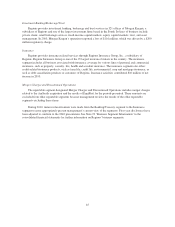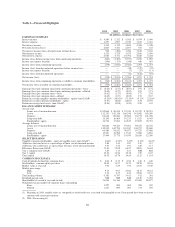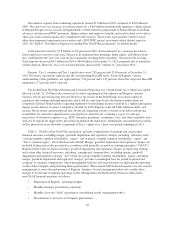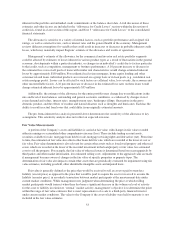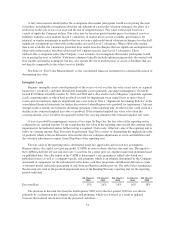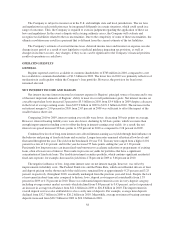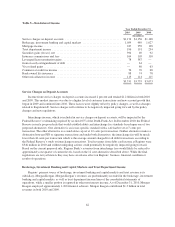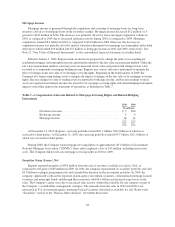Regions Bank 2010 Annual Report Download - page 69
Download and view the complete annual report
Please find page 69 of the 2010 Regions Bank annual report below. You can navigate through the pages in the report by either clicking on the pages listed below, or by using the keyword search tool below to find specific information within the annual report.In the fourth quarter of 2010, Regions reduced the company-specific component of its discount rate to
reflect several positive factors that occurred during the period, as well as factors which reduced the uncertainty of
future cash flow projections. Specifically, the Company earned a profit and experienced improving credit
metrics, including lower non-performing assets and lower gross inflows of non-performing loans than in the third
quarter of 2010. Additionally, Regions experienced lower levels of criticized loans, a leading indicator of loan
losses (see Note 5 “Allowance for Credit Losses” to the consolidated financial statements for further details,
including a definition of “criticized loans.”) The Company also completed its three-year strategic plan, which
reflected improving credit trends and included additional clarity around future cash flows that were driven by a
proposed rule issued by the Federal Reserve governing debit card income and the announcements in the fourth
quarter of 2010 and January of 2011 of pending non-distressed, orderly sales of financial institutions of
comparable size and/or footprint to Regions. Additionally, the Basel Committee finalized its capital framework,
which provided additional clarity on future equity requirements that impact the projections of future cash flows.
In the judgment of management, these factors outweighed the downgrades of Regions’ debt to below investment
grade during the fourth quarter of 2010, as well as new rules which are expected to increase FDIC insurance
premiums.
In estimating future cash flows, a balance sheet as of the test date and a statement of operations for the last
twelve months of activity for the reporting unit are compiled. From that point, future balance sheets and
statements of operations are projected based on the inputs discussed below. Cash flows are based on expected
future capitalization requirements due to balance sheet growth and anticipated changes in regulatory capital
requirements. The baseline cash flows utilized in all models correspond to the most recent internal forecasts and/
or budgets that range from 1 to 5 years. These internal forecasts are based on inputs developed in the Company’s
capital planning processes.
Refer to the discussion of intangible assets in Note 1 “Summary of Significant Accounting Policies” to the
consolidated financial statements for a discussion of these approaches and Note 8 “Intangible Assets” for a
discussion of the assumptions. The fair values of assets and liabilities are determined using an exit price concept.
Refer to the discussion of fair value in Note 1 “Summary of Significant Accounting Policies” and Note 21 “Fair
Value Measurements” to the consolidated financial statements for discussions of the exit price concept and the
determination of fair values of financial assets and liabilities.
In the fourth quarter of 2008, Regions performed its goodwill impairment tests for the Banking/Treasury
reporting unit, which resulted in an implied fair value of goodwill of approximately $4.7 billion and a goodwill
impairment charge of $6.0 billion. Throughout 2009 and continuing into the first half of 2010, in the Banking/
Treasury reporting unit, the credit quality of Regions’ loan portfolio declined, which contributed to increased
losses as well as elevated non-performing loan levels. Accordingly, Regions performed tests of goodwill for
impairment during each quarter of 2010 and during the second, third and fourth quarters of 2009 in a manner
consistent with the test conducted in the fourth quarter of 2008. The long-term fair value of equity was
determined using both income and market approaches (discussed in Note 8 “Intangible Assets” of the
consolidated financial statements). The results of these calculations continued to indicate that the fair value of the
Banking/Treasury reporting unit was less than its carrying amount. As of December 31, 2010, the carrying
amount and fair value of the Banking/Treasury reporting unit were $11.9 billion and $8.0 billion, respectively,
while the carrying amount of goodwill for the reporting unit was $4.7 billion. Therefore, Step Two of the
goodwill impairment test was performed. In Step Two, the fair values of the reporting unit’s assets and liabilities,
including the loan portfolio, intangible assets, time deposits, debt, and others were calculated. Once the fair
values were determined, deferred tax adjustments were calculated as applicable. The after-tax effects of the Step
Two adjustments, which were primarily write-downs of assets to fair value, exceeded any reductions in the value
of common equity determined in Step One; therefore, the results were no impairment for the Banking/Treasury
reporting unit. Since the second quarter of 2009, the fair values of net assets and liabilities of the Banking/
Treasury reporting unit have increased faster than the value of this reporting unit. Should the fair values of net
assets continue to increase more rapidly than the fair value of this reporting unit, goodwill could be impaired in
future periods.
55


